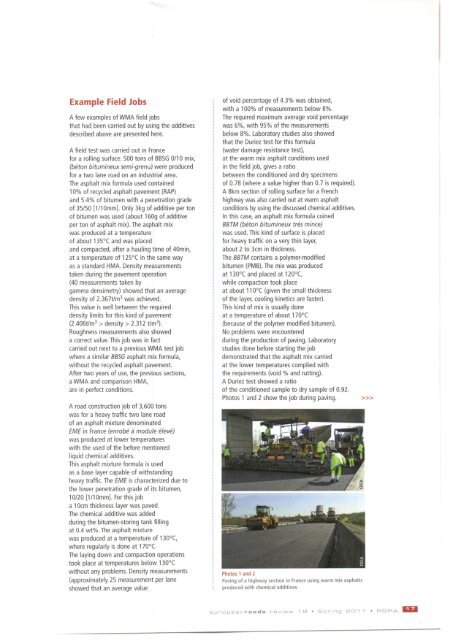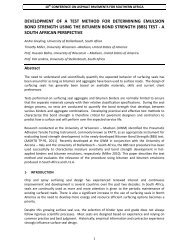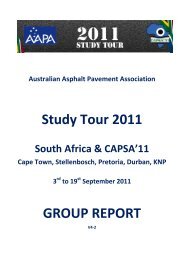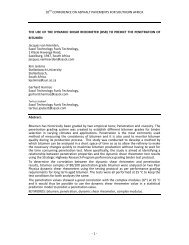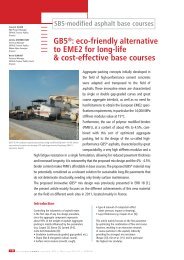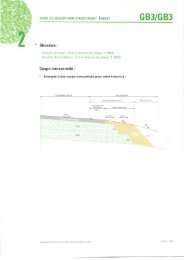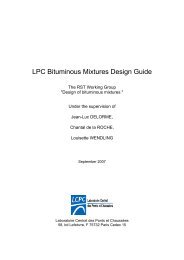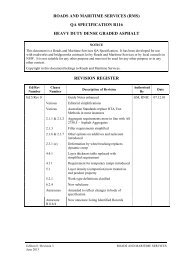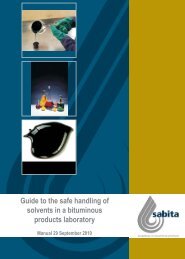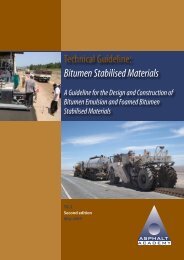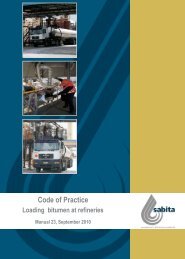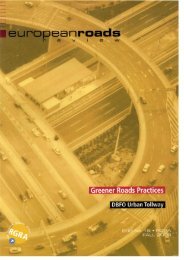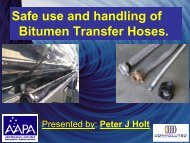<strong>Warm</strong> <strong>Mix</strong> ASPha ~<strong>Warm</strong> <strong>Mix</strong> <strong>Asphalt</strong>s (WMAs)with chemical additivesE ...z-; 280.,.:>.2 260The asphalt mix containing the additivewas prepared by adding 0.5 weight %of the additive to the bitumen,which was stirred for about 15 minutesbefore mixing it with the previouslyheated aggregates.The workability measurements were carried outusing a method developed in Gemanywith the collaboration of BaustofflaborHamburg (5). The test is based onmeasuring the torque of a rotational deviceintroduced into the asphalt mixture,simulating the movement of the mixthrough the paver during spreadingand laying of the mix at a given temperature.Figure 2 shows the results of torquefor the different asphalt mixtures,with and without additive, at 120 0 (and 160°C. The mix without additive goesthrough a large increase in torquewhen the temperature was decrease by 40°(,going from 292Ncm to 318Ncm.The mix with the additive already startswith a lower torque, higher workability,at 160 0 ( and reaches a torque of 290Ncm,which is quite similar to that measuredby the non-additivated mix at 120°C.These measurements showed that the testedadditives do have a positive impacton the workability of an asphalt mixture.This effect is not only attained at reducedtemperatures, as use to produce and pavewarm mix applications, but is also obtainedat higher temperatures. As it will be discussedbelow, this can result in other practicalapplications for this kind of additives,such as increasing the hauling timeof an asphalt mixture or simply enhancingthe workability of a difficult HMAwhen needed.320 ,---------------------~==~----------~300 +-----------------------Further tests were carried outon these asphalt mixtures to completethe study. Rutting tests on plaquesof asphalt mixture with and without additiveproduced at 140 0 ( were carried outon a Hamburg wheel test.The asphalt mix plaques were submergedin water at 60 0 ( during the 20,000 cycles tested.The results showed that the values of ruttingbetween the two samples were very close.The mixture that didn't contain the additiverut 4.4mm and the one containingthe additive rut 3.8mm. These results indicatethat the enhancing effect of the additiveson the mix workability at higher temperatures,do not degrade the final properties of the mix,as has been shown in previous publications (6).Given the low dosages of additive used,compared to the mass of bitumen,it is likely to believe that these additiveswork only at the interfaces between the bitumenand the mineral aggregate at the momentthey are placed in contact during production.This assumption seems reasonablegiven the surfactant nature of the chemical additivesused. The presence of these chemical additivesat the interface must play an important rolein the covering process of the mineral aggregateby the bitumen during the production process.By decreasing the surface tensionbetween the bitumen and the aggregate,the additives could compensate for the higherbitumen viscosity at lower temperatures,allowing a complete coverage.However, this is not enough to providethe workability observed by the useof these additives. The presence of the additivesat the bitumen and mineral aggregateinterface should play an important roleon the frictional forces between the elementsof the asphalt mix and how the applied forcesare distributed during compaction.In addition, the presenceof these additives at the interfacemay also help with the overall adhesionof the bitumen to the mineral aggregates,as was observed in water resistance tests [6, 71.where the cohesion of the conditioned samplewas significantly improved.240Referenceasphalt mix160·(<strong>Asphalt</strong> mixwith 0.5%additiveReferenceasphalt mix120·(<strong>Asphalt</strong> mixwith 0.5%additiveFigure 2Workability of asphalt mixtures with and without the chemical additiveat the indicated temperatures~ europeanroads review 1 B • Spring 2011 • RGRA
Example Field JobsA few examples of WMA field jobsthat had been carried out by using the additivesdescribed above are presented here.A field test was carried out in Francefor a rolling surface. 500 tons of BBSG 0/10 mix,(beton bitumineux semi-grenu) were producedfor a two lane road on an industrial area.The asphalt mix formula used contained10% of recycled asphalt pavement (RAP)and 5.4% of bitumen with a penetration gradeof 35/50 [1/1 Ommj . Only 3kg of additive per tonof bitumen was used (about 160g of additiveper ton of asphalt mix). The asphalt mixwas produced at a temperatureof about 135°( and was placedand compacted, after a hauling time of 40min,at a temperature of 125°( in the same wayas a standard HMA. Density measurementstaken during the pavement operation(40 measurements taken bygamma densimetry) showed that an averagedensity of 2.367t1m 3 was achieved.This value is well between the requireddensity limits for this kind of pavement(2.406t1m 3 > density > 2.312 tlm 3 ).Roughness measurements also showeda correct value. This job was in factcarried out next to a previous WMA test jobwhere a similar BBSG asphalt mix formula,without the recycled asphalt pavement.After two years of use, the previous sections,a WMA and comparison HMA,are in perfect conditions.A road construction job of 3,600 tonswas for a heavy traffic two lane roadof an asphalt mixture denominatedEME in France (enrobe a module eleve)was produced at lower temperatureswith the used of the before mentionedliquid chemical additives.This asphalt mixture formula is usedas a base layer capable of withstandingheavy traffic. The EME is characterized due tothe lower penetration grade of its bitumen,10/20 [1/10mmj. For this joba 10cm thickness layer was paved.The chemical additive was addedduring the bitumen-storing tank fillingat 0.4 wt%. The asphalt mixturewas produced at a temperature of 130°( ,where regularly is done at 170°(,The laying down and compaction operationstook place at temperatures below 130 0 (without any problems. Density measurements(approximately 25 measurement per laneshowed that an average valueof void percentage of 4.3% was obtained,with a 100% of measurements below 8%.The required maximum average void percentagewas 6%, with 95% of the measurementsbelow 8%. Laboratory studies also showedthat the Duriez test for this formula(water damage resistance test),at the warm mix asphalt conditions usedin the field job, gives a ratiobetween the conditioned and dry specimensof 0.78 (where a value higher than 0.7 is required).A 8km section of rolling surface for a Frenchhighway was also carried out at warm asphaltconditions by using the discussed chemical additives.In this case, an asphalt mix formula coinedBBTM (beton bitumineux tres mince)was used. This kind of surface is placedfor heavy traffic on a very thin layer,about 2 to 3cm in thickness.The BBTM contains a polymer-modifiedbitumen (PM B). The mix was producedat 130 0 ( and placed at 120°(,while compaction took placeat about 11 OO( (given the small thicknessof the layer, cooling kinetics are faster).This kind of mix is usually doneat a temperature of about 170 0 ((because of the polymer modified bitumen).No problems were encounteredduring the production of paving. Laboratorystudies done before starting the jobdemonstrated that the asphalt mix carriedat the lower temperatures complied withthe requirements (void % and rutting) .A Duriez test showed a ratioof the conditioned sample to dry sample of 0.92.Photos 1 and 2 show the job during paving. »>Photos 1 and 2Paving of a highway section in France using warm mix asphaltsproduced with chemical additiveseuropeanroads review 1 B • Spring 2011 • RGRA IIIIiD
- Page 1 and 2: europeanrr;»adsrev lew
- Page 3 and 4: Jean-louis MarchandPublication Mana
- Page 5 and 6: europeanroadsrev i e wSustainable D
- Page 7 and 8: of the aggregate particles. Product
- Page 9 and 10: lean-Paul FORTDirectorCOLAS Solutio
- Page 11 and 12: significant with the Hamburg Loaded
- Page 13 and 14: Site informationOriginal PG binderR
- Page 15 and 16: Average Warm Mix density behind the
- Page 17: They are usually used at lower dosa
- Page 21 and 22: 170160E 150.. 140~ 130! 120~ 110100
- Page 23 and 24: Sundaram lOGARAJBusiness Developmen
- Page 25 and 26: Mix temperature, °CCore density Re
- Page 27 and 28: Texas Type D surface course with 5.
- Page 29 and 30: the optimum additive contentand the
- Page 31 and 32: Thus, it was observed a great reduc
- Page 33 and 34: 14,000 --HF8M (HMA 50/70)---HF8M (W
- Page 35 and 36: AIPCRComite franc;ais~~ ......... ,
- Page 37 and 38: In land waterway 3.6".Rail 10.8%AJr
- Page 39 and 40: Theresa ROMEllSenior Transportation
- Page 41 and 42: The basic method for measuring prev
- Page 43 and 44: **.• ** *The Voice of the Europea
- Page 45 and 46: IBEF: raising global awarenessand r
- Page 47 and 48: The damage observed on some roads,
- Page 49 and 50: 70%60%50%40%30%20%10%0%90%In Irelan
- Page 51 and 52: 15 years after, the new editionof t
- Page 53 and 54: • • ~;, "~.Photo 1HTPT Simulato
- Page 55 and 56: Table 1Vehicle simulatorloading cas
- Page 57 and 58: As a result, the impact of wheel-lo
- Page 59 and 60: In Switzerland, standard asphalt mi
- Page 61 and 62: Swiss referencesTo date, over 30,00
- Page 63 and 64: Fran~oi s OLARDPatrick HUONStephane
- Page 65 and 66: DDDMix with highfines contentP < Px
- Page 67 and 68: This parameter, of primary importan
- Page 69 and 70:
Thick Bituminous Pavement Structure
- Page 71 and 72:
Lars LADEHOFFLaboratory ManagerCola
- Page 73 and 74:
The findings are detailed in Table
- Page 75 and 76:
Nanosoft developmentResearch perfor
- Page 77 and 78:
Safety-enhancing achievements .~Ant
- Page 79 and 80:
www.eecongress2012.org


